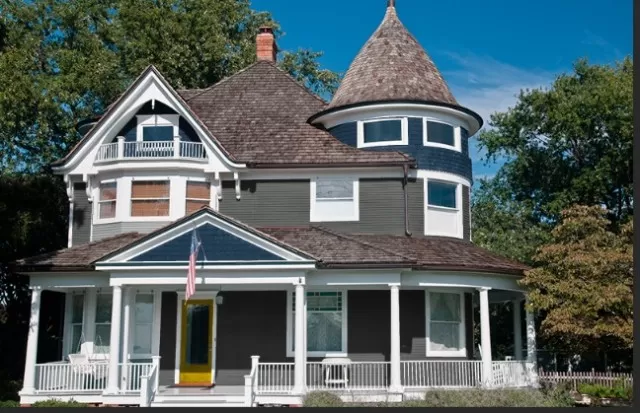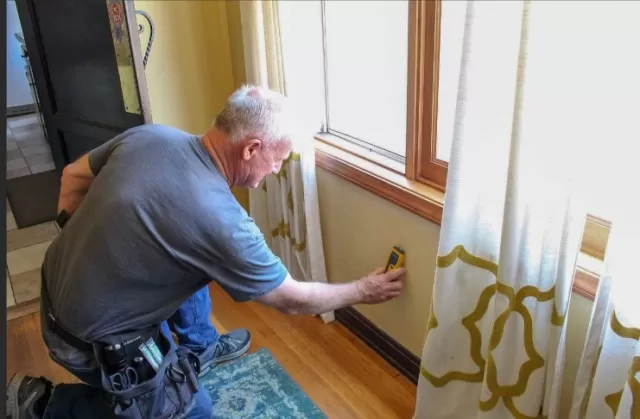Insights into Buying an Older Home: Unspoken Realities. Buying an older home is like opening a door to a rich tapestry of history, charm, and character. While the allure of vintage architecture and unique details may captivate your imagination, there are certain realities that often remain unspoken.
As you step into this world of antiquity and craftsmanship. In the end, buying an older home is an invitation to embrace the past while crafting your own future. It’s a journey that intertwines nostalgia with innovation, heritage with modern living. As you embark on this path, armed with both practical knowledge and an appreciation for the intangible, you become a steward of a piece of history, adding your chapter to the ever-evolving story of your home.
Embrace the Enchantment, but Arm Yourself with Awareness

A Journey Through Time: The Evolution of Construction and Design Standards.
In the ever-evolving realm of construction materials and architectural codes, the progression over the past few decades has been nothing short of remarkable.
The result is a collection of homes that stand as testament to human ingenuity, boasting unprecedented efficiency and functionality. However, amidst this wave of innovation, an interesting paradox emerges.
While today’s houses shine with a certain uniformity, evoking a sense of familiarity, the dwellings of yesteryear emanate a distinct charm derived from their bespoke craftsmanship and unique embellishments.
The tapestry of architectural history is woven with threads of individuality, each historical home a masterpiece unto itself.
These cherished relics, painstakingly designed and adorned with intricate details, offer a glimpse into a bygone era where imagination knew no bounds. Each nook and cranny tells a story, a testament to the dedication and artistry of those who built them.
Yet, for all their allure and captivating allure, these venerable structures often stand as a testament to a simpler time.
Modern conveniences that have become second nature to us now were once unimagined luxuries. As prospective homeowners embark on a quest to acquire a piece of history, they must also prepare to navigate the idiosyncrasies that come hand in hand with these time-honored abodes.
From whimsical quirks to charming eccentricities, the houses of yore are more than just structures; they are gateways to the past.
A creaky floorboard whispers of countless footsteps that have trod upon it, and a vintage window frame captures the dance of sunlight from generations past. As potential buyers step into this enchanting world, they do so with open hearts and a readiness to embrace the unexpected.
In this age of contemporary marvels, where technology and innovation have revolutionized the way we live, it’s essential to remember the roots from which we’ve sprung.
The juxtaposition of past and present presents a unique opportunity—one that encourages us to revel in the charm of days gone by while equipping ourselves with the knowledge to navigate the nuances that accompany it.
So, while we invite you to be charmed by the allure of historic homes, we also implore you to arm yourself with awareness.
As you embark on this journey through time, Be Prepared to cherish the timeless beauty of bespoke architecture, to accept the quirks and eccentricities as part of the tapestry, and to write the next chapter of these living treasures’ stories.
Navigating Property Line Quandaries in Historic Neighborhoods
Untangling the Threads of Property Boundary Dilemmas.
In the charming tapestry of historic neighborhoods, where stories of the past blend seamlessly with the present, property lines often weave a tale of their own.
The idyllic image of a quaint picket fence gracing your landscape can, at times, prove to be an illusion, as the intricate dance of boundaries may reveal a different narrative altogether. Beneath the surface of such neighborhoods lies a labyrinth of history, where handshakes of generations past have shaped the landscape in unexpected ways, leading to intriguing property line enigmas.
The origins of these enigmas can be traced back to a bygone era, where casual agreements and gentlemanly understandings defined the contours of land use.
A neighborly accord that decided the placement of a garage or the positioning of a majestic tree might have been sealed with nothing more than a handshake, etching an unwritten understanding into the annals of time. However, as the years rolled on, memories faded, documents disappeared, and what once seemed a harmonious arrangement could evolve into a tangled web of uncertainty.
In the face of these historical intricacies, one must tread with caution, for the lines that demarcate property boundaries might hold secrets that even the passage of time cannot fully unveil.
Consider a scenario where a garage, built decades ago, stands sentinel a few feet astray from its designated boundary, or where the canopy of a time-honored tree spans two domains, casting its shade upon the realm of ambiguity.
For those confronted with such conundrums, a nuanced approach becomes imperative.
The passage of time has endowed these anomalies with an air of normalcy, as if they were integral threads in the neighborhood’s fabric. The decision to rectify these intricacies may involve embarking on a journey through the legal labyrinth, a path that demands time, resources, and a willingness to unravel the historical skein.
Alternatively, one might find solace in embracing the status quo, allowing the poetic imperfections of the past to continue their dance across property lines.
In this complex tale of historic charm and unanticipated entanglements, the choice lies in how one chooses to engage.
Whether to engage in a battle of legal wits or to embrace the quirkiness of shared histories, the decision should be a reflection of not only the present circumstances but also a nod to the footsteps that have come before.
As you traverse the mosaic of property lines in these enchanting neighborhoods, remember that each crooked boundary and every misaligned landmark whispers a tale of days long past.
With a blend of respect for tradition and an understanding of modern legalities, you can navigate these intriguing property line narratives and make a choice that resonates with the spirit of the place you now call home.
Unveiling Asbestos: A Critical Aspect of Home Sales

Illuminating the Shadows: Understanding Asbestos Disclosure and Considerations.
In the intricate realm of home sales, transparency reigns supreme.
A crucial facet of this transparency revolves around the disclosure of asbestos, a silent presence that can often lie dormant within the very fabric of a house. Sellers, while bound by the responsibility to share pertinent information, are mandated to unveil the existence of asbestos only when it is within their knowledge, thereby exempting them from conducting comprehensive testing throughout the entire dwelling.
However, when the home boasts a history that predates the year 1970, a curtain of caution is advisable to be drawn, as the legacy of asbestos could potentially be woven into its very structure.
The whispers of history are often etched into the architecture of a house, and those built prior to 1970 carry within them the possibility of housing asbestos in discreet forms—perhaps concealed within pipe insulation, lingering in flooring tiles, or surreptitiously integrated into construction materials.
This once widely embraced material, admired for its fire-resistant and durable attributes, has since been overshadowed by the grave health concerns it poses when its fibers are disturbed and released into the air.
As potential guardians of a historical treasure, it is prudent to equip oneself with knowledge—specifically, delving into the recommendations set forth by the Environmental Protection Agency (EPA) for managing the presence of asbestos.
The labyrinth of asbestos-related matters can be complex, but the EPA’s guidance serves as a guiding light, outlining safe practices for identification, containment, and remediation.
When peering into the past, it becomes evident that our homes bear the fingerprints of those who once inhabited them.
The very essence of a house constructed before 1970 is steeped in the era’s architectural aesthetics and material choices. While this carries undeniable charm, it also brings a potential burden—one that necessitates a heightened sense of awareness and consideration for the well-being of those who dwell within.
As the curtain falls on one chapter and rises on another during the process of selling a house, the spotlight turns to the presence of asbestos.
It is a topic that beckons us to unveil the layers of history with honesty, to navigate the complex landscape of disclosure, and to make decisions that reflect both the legal obligations and the moral responsibility to provide a safe living environment.
So, while the mandate for asbestos disclosure remains tethered to the bounds of knowledge, the wisdom of the past speaks loudly.
It is a prudent course of action to acquaint oneself with the potential legacy of asbestos within homes built before 1970, to heed the counsel of regulatory bodies, and to ultimately contribute to a harmonious transition of ownership—one that acknowledges the past while safeguarding the future.
Unveiling the Veil of Lead Paint: A Seller\’s Duty and a Homeowner\’s Caution
Peeling Back the Layers: Navigating Lead Paint Disclosure and home improvement.
Within the realm of home transactions, transparency is a guiding principle that weaves trust between sellers and buyers.
Much like the disclosure of asbestos, the presence of lead-based paint holds a place of significance. Sellers are not obligated to conduct exhaustive lead paint testing; however, their responsibility lies in candidly revealing their personal awareness of its existence.
In the context of homes erected before 1978, a prudent approach is to regard all paint with suspicion and to adopt proactive measures.
The historical narrative of homes is often painted in layers, each hue representing a moment in time.
For dwellings that stand as relics of yesteryears, built before the year 1978, the possibility of lead-based paint being a part of this story is very real. This once prevalent substance, prized for its durability and vibrant colors, has since been shadowed by the dangers it poses to human health, particularly to children and pregnant women.
A homeowner’s journey is replete with opportunities for rejuvenation and transformation.
During the process of remodeling or renovation, a vigilant eye is required to ensure that the specter of lead-based paint does not cast its toxic veil. The Environmental Protection Agency (EPA) stands as a beacon, offering a set of lead-safe guidelines that serve as a compass through this intricate landscape.
Among these measures is the imperative to minimize the generation of dust, a potential carrier of lead particles, and to opt for painting over existing painted surfaces instead of attempting to strip away the layers of history.
Much like a painter adding careful strokes to a canvas, a homeowner can navigate the realm of lead paint with prudence and mindfulness.
This involves approaching every brushstroke and renovation task with an understanding of the potential hazards and the wisdom to implement the EPA’s guidelines.
As the spotlight shifts from the seller’s disclosure to the homeowner’s proactive engagement, the narrative continues to unfold.
It is a chapter that emphasizes a dual responsibility: one that calls for candid communication and awareness from sellers, and another that beckons homeowners to don the mantle of stewardship, preserving the historical integrity of a property while safeguarding the health and well-being of its inhabitants.
In the symphony of homeownership, each note is a decision, and each decision shapes the melody of a place that holds memories and aspirations.
When lead paint lingers in the background, these decisions carry added weight. Through knowledge, awareness, and adherence to safety protocols, the story of lead paint transforms from a potential hazard into a tale of responsible choices and the harmonious coexistence of past and present.
Unlocking the Mystery of Low Water Pressure in Vintage Homes

Unraveling the Riddle: Understanding Low Water Pressure in Older Residences.
Within the enchanting tapestry of vintage homes, a peculiar phenomenon often emerges—low water pressure.
The charm of these time-honored abodes comes with an intricate story, one that is interwoven with the history of plumbing and the evolution of modern conveniences. A journey into the past reveals a landscape where the concept of a single bathroom reigned supreme, where dishwashers and washing machines were distant dreams, and where water supply lines mirrored the modest needs of the era.
Picture a time when the rhythm of life was less hurried, and the demands on water resources were considerably lighter.
The houses of yore were not adorned with the water-hungry luxuries that grace contemporary living spaces. As a consequence, the infrastructure that facilitated water flow, both within the home and throughout the neighborhood, did not demand the robustness of today’s expansive water lines.
In some pockets of history-rich neighborhoods, the tale has taken a different turn.
Undertakings to modernize and adapt to changing times have led to the upgrading of undersized water lines, thus breathing new life into the plumbing systems of bygone eras. Yet, for some fortunate locales, these enhancements have yet to ripple through the veins of the community, leaving a vestige of the past—a gentle reminder that the march of progress is not always uniform.
As you cross the threshold into a vintage home, the whimsical quirks and nostalgic features welcome you with open arms.
Among them, the sensation of low water pressure might stand out, like a whispered secret from generations long past. It’s a phenomenon that invites a pause, a moment of reflection on the subtle intricacies that connect the past with the present.
While low water pressure might be a vestige of times gone by, it need not be a source of dismay.
With an understanding heart, you can embrace this quirk as a testament to the history that lives within the walls. Should the modern amenities of robust water pressure not yet grace your neighborhood, a touch of patience and the knowledge of what lies beneath the surface can transform this peculiarity into a badge of authenticity.
In the grand tapestry of vintage homeownership, each thread tells a tale.
The dance of low water pressure is but one chapter, a reminder of the ebb and flow of progress and the intimate connection between your home and the echoes of time. As you savor the charm of your abode, remember that even the subtlest whispers of history can shape the narrative of a place you proudly call home.
*The information is for reference only.